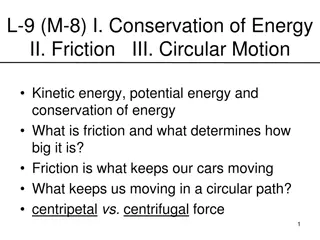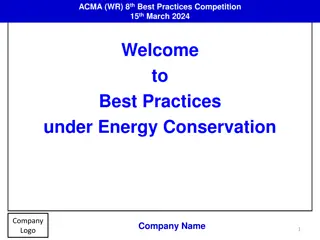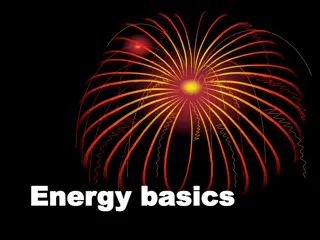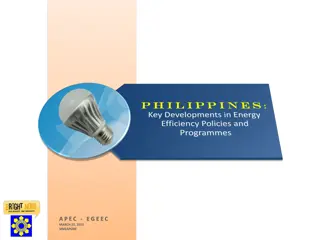Understanding Energy Conservation: Types, Importance, and Practices
Energy conservation is crucial for sustainable living. Learn about different types of energy, the reasons to conserve energy, and practical steps for energy efficiency. Explore the evolution of energy use from traditional sources to modern technologies, and the shift towards renewable energy systems for a greener future.
Download Presentation

Please find below an Image/Link to download the presentation.
The content on the website is provided AS IS for your information and personal use only. It may not be sold, licensed, or shared on other websites without obtaining consent from the author. Download presentation by click this link. If you encounter any issues during the download, it is possible that the publisher has removed the file from their server.
E N D
Presentation Transcript
Agenda What is energy? Types of energy. Why to conserve energy? What can we do? Energy conservation in industries. Energy conservation in India.
What is energy? Energy is defined the ability or capacity to do work. Energy lights our cities, powers our vehicles and runs machinery in factories. It warms and cools our homes, cooks our food, plays our music and gives us pictures on television.
Energy use has changed a great deal since people relied solely on the sun, their own strong bodies or beasts of burden as energy resources.
Long ago, people learned how to use water power to turn paddle wheels and wind power for transportation and irrigation.
People learned to use the chemical energy stored in materials like wood to cook and heat their homes.
But machines and technologies introduced during the Industrial Revolution of the late 18thcentury required the use of other energy resources, especially fossil fuels.
Types of Energy Renewable energy : It is the energy obtained from sources that are essentially inexhaustible such as sun and wind. Non-renewable energy: It is the energy that comes from the ground and is not replaced in a relatively short amount of time.
Non-renewable energy examples Thermal power plants using fossil fuels such as coal, petroleum oil or natural gas. Nuclear power plant
Renewable Energy A renewable energy system converts the energy found in sunlight, wind, falling water, sea waves, geo-thermal heat or biomass into a form, we can use such as heat or electricity.
Renewable Energy Examples Solar energy Wind energy Hydro power Biomass Geo-thermal Tidal energy Wave energy Ocean Thermal Energy Conversion (OTEC)
Solar Power Solar power is a promising, renewable energy resource than can be turned into electricity, and it is used in many toys and even home heating.
Wind Energy Wind power is increasingly being used as a clean source of renewable energy. Turbines harvest wind on wind farms and generate electricity.
Hydro Power Hydroelectric plants use running water to generate electricity, however they may flood nearby lands and can disrupt the normal flow of water, both of which negatively affect the environment.
Geothermal Power Geothermal power uses the earth s natural heat to generate electricity.
Tidal Power Tidal power is a form of hydropower that converts the energy obtained from tides into electricity.
OTEC In OTEC, we use the temperature difference between the hot surface of the ocean and the cooler, deeper layers beneath to generate electricity.
Energy Conservation Energy conservation is the practice of decreasing the quantity of energy use for the same quality and quantity of Output. It may be achieved through efficient use, in which case energy use is decreased while achieving a similar outcome. Energy conservation also includes prevention of misuse of energy.
Why to Conserve Energy Our energy demands are continuously increasing (about 14% per year) In 2015-16, India s energy demand was 1114408 MU and availability was 1090851 MU (2.1% shortage). Similarly, peak demand was 153366 MW and availability was 148463 MW (3.2% shortage).
Why to Conserve Energy .. To make up the gap between demand and supply, new power plants have to be installed, which requires capital and time. To meet the growing demand, it has been assessed that additional generating capacity of 1 lakh MW has to be added by 2017 requiring an investment of Rs. 8,00,000 crore approximately. An alternative is Energy Conservation. Energy Conservation measures can reduce power demand and prune building up of additional generating capacity to the extent it can be conserved.
Why to Conserve Energy .. We have limited resources of fossil fuels available on Earth. 60% resources are consumed so far. We need a sustainable growth and save the resources for future generations. Energy conservation is one way to achieve this. Our electricity bill becomes less.
It is not merely a technological issue but it encompasses much broader management issues. economic and The measures is well established as one unit of energy saved at the consumer end avoids nearly 2.5 to 3 times of capacity augmentation due to plant load factor, plant availability, consumption. cost effective of energy conservation auxiliary power
Why to Conserve Energy .. Thermal power shares about 65% of total electricity in India and also in the whole world. Poisonous gases such as CO, NOx, SOXand ash are released to the atmosphere causing environment pollution. CO2 is released, which is the main factor for global warming and climate change.
Sector wise Energy Consumption Type of Consumer Percentage of Consumption 5 Agricultural Industry Transport Residential Others 49 22 10 14 Agricultural Industry Transport Residential Others
Energy Saving Potential Sector Potential(%) Economy as a whole Up to 23 Agricultural Up to 30 Industrial Up to 25 Transport Up to 20 Domestic and Commercial Up to 20
Electricity Used for Lighting Nearly 10% of the electricity is consumed for lighting in the residential & commercial building. This amounts to a connected load of approx. 11,000 MW and annual electricity consumption of 50 billion KWh.
Energy savings in lighting System Make maximum use of natural light (translucent sheets/morewindows and openings) Switch off when not required Modify lighting layout to meet the need Select lightcolors for interiors Provide timerswitches / PV controls / photo sensors Provide lighting Transformer to operate at reduced voltage Install energy efficient lamps, luminaries and controls Clean translucent sheet and luminaries regularly
Comparison Chart LED Light, Incandescent Light & CFL Efficiency & Energy Costs Energy Light Emitting Diodes (LEDs) Incandescent Light Bulbs Compact Fluorescents (CFLs) Life Span (average) 50,000 hours 1,200 hours 8,000 hours Watts of electricity used 6 - 8 watts 60 watts 13-15 watts Units of Electricity used (30 Incandescent Bulbs per year equivalent) 329 KWh/yr. 3,285 KWh/yr. 767 KWh/yr. Annual Operating Cost (30 Incandescent Bulbs per year equivalent) Rs 1,316/year Rs 13,140/year Rs 3,068/year
Energy Saving in Lighting Separate lighting Transformer To isolate from power feeder Toavoid voltage fluctuation problem Energysaving atoptimum voltage Install Servo stabilizer if separate transformer is not feasible Electronic ballast Energysavings 30 to 35% Less heat load intoA/C room Metal halide in place of Mercuryand SVL lamps CFT in place of incandescent lamps
Energy Saving in Fan Fans are used extensively in summer months. Use of high efficiency fan motor and use of electronic regulator (in place of regulator) can lead to about 20% saving in energy. The fans with aerodynamic impellers consume about 20% less energy but are 30% costlieras compared toconventional fans. conventional resistance designs and improved
Energy Saving in Refrigerator The efficiency of refrigerators in India, is rather poor. A typical 165 consumes about 540 KWH per year. Whereas on the other hand the 200 ltr. Korean model consumes about 240 efficiency refrigerator are not manufactured in India. This refrigerators use a different compressor design which are very sensitive to voltage of electric supply. Unless quality of electric supply is improved this refrigerators can not be improved in India. ltr. Indian refrigerator KWH per year. High
Energy Conservation in Industries Energy saving potential in different industrial equipments: Boiler Compressor Furnace Diesel Generating Set Motor Pump Refrigeration
Energy Saving in Motors The electric Motors form the heart of the industries, out of the total motors in operation 98% Motors. Induction Motors consumes 70% of the total Electrical Energy generated. are Induction Capacity of Motors Torque V2
Energy Saving in Motors Causes for Energy Loss in Induction Motors The Various causes of Energy Loss in Induction Motors are due to the following factors: Oversized Motors Rewound Motors ImproperVoltage Less Efficient Motor Driven Equipment Idle Run
Energy Saving in Motors Oversized Induction Motor Sizing of Motors plays a vital Role in Energy Efficiency. It is very difficult to choose a right size of Motor in a single step application. In any industry while designing the capacity of motor for a particular two/three stages. Over sizing of motor is very common in typical industry application involves
Energy Saving in Motors Oversized Induction Motor (contd.) The major reasons for over sizing of motors may be due to ::: Starting torque requirements Excess cushion & safety factors Adhocdecisions
Energy Saving in Motors Rewound Motors Rewound Induction Motors are common in Indian Industries. Especially, in Textiles, Paper industries and Un-organised sectors such as small Flour mills, Lathe shop and Agricultural farms. Induction Motors are used even after more than fourtimes rewound.
Energy Saving in Motors Rewound Motors (contd.) Reason for loss in efficiency Rewound Motors ::: Eddy Current loss eddy current loss is proportional to the square of the thicknessof the lamination At the time motor coil burning the temperature of the winding rises more than 400oC, this temperature will evaporate the varnish insulation between lamination of both rotorand stator this results in increaseof eddycurrent loss
Energy Saving in Motors Presence of carbon: the stator and rotor core is made up of thin stamping (0.28mm to 0.45mm). The stamping are insulated from each other by varnish insulation coating, which consists of hydrocarbon. Therefore while motor coil burns varnish also burns and evaporates. The resulting deposition of some unburned carbon between the stampings deteriorates the magnetic property and hence the magnetic loss increases.
Energy Saving in Motors ImproperVoltage The performance of any induction motor will be good, when the voltage/frequency ratio should be maintained constant. If a 380 Volt 50 Hz designed induction motor operated with 415V, 50Hz will lead to excess magnetisation loss. This will be the case in many of the imported motors designed for other frequency and voltage than Indian frequency & voltage.
Energy Saving in Motors Less Efficient Motor Driven Equipment Earlier for variable speed, welding application etc., Motor Generator sets are used. This is the Energy Inefficient practice. This offers a good scope to reduce energy consumption by using the latest technology to meet the requirements For example the recent method to get accurate variable speed control can be achieved by using Thyristor drives which is the ideal replacement for Ward Leonard drive. Similarly Motor Generator set is used forwelding application.
Energy Saving in Motors Presently few machines are driven by Ward Leonard drives for better speed control. From Energy Efficiency point of view Ward Leonard drives are inefficient and operating efficiency is only 70 to 80% for full load condition. The power measurements indicated that no load power consumption of the drive varies from 10 to 14%. The modern Thyristor drives with fine speed control is popular in Industry and its efficiency is around 90 to 98%. consumption is almost negligible. The no load power
Energy Saving in Motors Idle Run In some of the industrial applications, the auxiliary equipment need to run even main equipment is switched off. There is a possibility to switch off whenever possible by incorporating controls like interlocks and timer based controllers. This will reduce the idle running timeand energy consumption.
Energy Conservation in Industries Air Compressors Compressed air is used in almost all types of industries and accounts for a major share of Electricity used in some of the plants. It is utilized for a variety of end uses such as pneumatic tools and equipment, instrumentation , conveying ,etc and is preferred in industries because of its convenience and safety.
Compressed air is very energy intensive .Only 5% of electrical energy is converted to useful energy. Use of compressed air for cleaning is rarely justified Ensure low temperature of inlet air. Increase in inlet air temperature by 3 C increases power consumption by 1%.
Energy Conservation in Industries It should be examined whether air at lower pressure can be used in the process. Reduction in discharge pressure by 10% saves energy consumption up to 5%. A leakage from a diameter hole from compressed air line working at a pressure of 7kg /cm2 can drain almost Rs. 2500 per day. Air output of compressors per unit of electricity input must be measured at regular intervals. Efficiency of compressors tends to deteriorate with time.
Energy Conservation in Industries Cooling Towers: A cooling tower is a specialized heat exchange in which two fluids ( air and water) are brought into direct contact with each other to effect the transfer of heat. In a spray filled towers , this is accomplished by spraying a flowing mass of water into a rain- like pattern, through which an upward moving mass flow of cool air is induced by the action of a fan.
Replacement of inefficient aluminum or fabricated steel fans by moulded FRP fans with aerofoil designs results in electricity saving in the range 15-40%. Install automatic on-off switching of cooling tower fans and save up to 40% on electricity costs.
Energy Conservation in Industries Pumps: Most of the industrial processes in and out of plants involve transportation of fluids and the pump is the only mechanical means available to facilitate this transportation. The prime movers can either be an electric motor, a diesel engine, on a steam/ gas turbine. All prime mover consume energy, either in the form of electric power or precious petroleum products like diesel , oil or gas, to impart working capacity to the pump.
Select a pump of the right capacity in accordance with the requirement. Improper selection of pumps can lead to large wastage of energy. A pump with 85% efficiency at rated flow may have only 65% efficiency at half the flow Matching of motor with appropriate sized pump.








 undefined
undefined



























